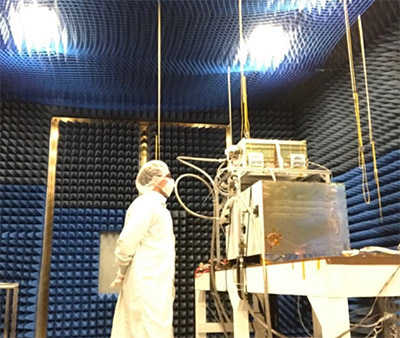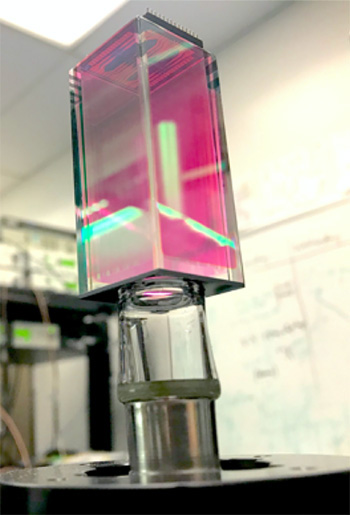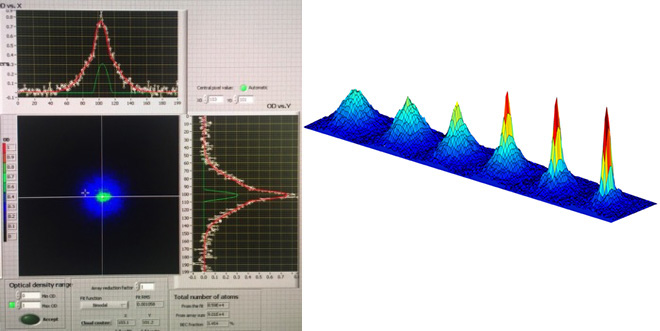
“The best laid plans of mice and men” is a reminder that preparation cannot protect us from the unpredictable universe we live in. The laws of physics seem to conspire to that end. Quantum physics shows just how much probabilities, or chance, decide what happens. This quantum nature is woven into the fabric of the universe at a subatomic level, although it is rare to see at scales we can actually observe – one notable exception: Bose-Einstein Condensates (BECs). Named after the two physicists that theorized their existence nearly a century ago, BECs were proven to exist in a lab environment as recently as the 1990s. At high temperatures atoms behave as particles, but at very cold temperatures their wave nature becomes more pronounced. They begin to form a very pure vapor cloud, which can be cooled off even more using lasers and magnetic fields. At the critical temperature and density, the wavelengths of the atoms begin to overlap and they share the same macroscopic wave function. The very cold, very dense cloud of atoms then becomes a fifth state of matter (solid, liquid, gas, plasma, and): BEC. As Ethan Elliot, a technologist and researcher of BECs put it, “atoms don’t want to be this cold – they’re fighting entropy and [those underlying quantum] probabilities that keep them from existing in this state.”
Enter the Cold Atom Laboratory (CAL): flying 254 miles above us on the International Space Station (ISS), researchers study ultracold atoms and BECs remotely while working very closely with astronauts on orbit. Developed at NASA’s Jet Propulsion Laboratory in Pasadena, California, CAL is a success story so unique that we decided to take a closer look at what made this project. We’ll look at what CAL’s good fortune has brought us, what bad luck nearly ended the project more than once, and how this was handled – in ways reminiscent of what they were studying: a macroscale entity displaying quantum properties.
The Good

Just understanding BECs, or “quantum gas,” is worth our effort. When plasma, the fourth state of matter, was first investigated, nobody predicted it would eventually be used everywhere from lighting, metallurgy, microelectronics, TVs, exhaust cleanup, and advanced engines. BECs also let us simulate inaccessible places, like the interior of neutron stars. Cold atom research can contribute to making finer accelerometers, understanding high temperature superconductors, quantum key distribution for encryption, ultra-high precision atomic clocks, and much more advanced sensors – particularly measurements of gravity. Gravity measurements are key to unravelling the mystery of “dark” matter, the unseen stuff that makes up about five times more of our universe than the “normal” matter we see and are made of.
If researchers discovered BECs on Earth, then why would anyone want to study them in space? Cold atoms are good for detecting gravity because their wave-like nature can be extremely sensitive to inertial forces. That’s why it’s necessary to perform such high-sensitivity gravity measurements in freefall. On Earth, the BECs will fall by as much as 10 meters in a little over a second. In the microgravity environment of space though, the cold atoms in CAL can experience free-fall for much longer, and these atoms can reach temperatures below 100 pK, unlocking the potential to observe new quantum phenomena. CAL is the only facility like this that exists today.
CAL also pioneered an entirely new technique: chip-based sympathetic cooling of potassium via rubidium – and on a flight project schedule. CAL operates, not from a room-sized lab as every other quantum gas experiment, but from a container about the size of a mini-fridge. CAL is also one of the first labs to be entirely remote controlled: calibrating that individuals had to do onsite before each new experiment is now done from over 254 miles away.
Most technologies that fly to space require so much testing and validation – since you only get that one shot to get to space – that the technology is no longer state of the art by the time it gets up there. That tradeoff’s value: the technology is reliably understood. CAL however, needed to be cutting edge. It has three atomic species; microwave state selection and adiabatic rapid passage techniques enable any of 24 different quantum states to be prepared (with an infinite number of mixtures and superpositions). The Feshbach coils allow for the precise control of interactions between atoms in certain states. Bragg beams will enable atom interferometry, but are also a sensitive way to probe a variety of condensate properties. High- and low-resolution imaging allow scientists to view atom clouds from two directions. Decompression and delta-kick cooling allows scientists to access a previously unexplored range of effective temperature and enables precise focusing and shaping of atomic clouds.
Reading about it now, it may be hard to believe that CAL almost didn’t fly. The final product is the culmination of years of work and the overcoming of challenge after challenge after surprise. Jason Williams, CAL Principal Investigator recalls “the last year and a half is a blur because so much went into the final stages.” As another CAL team member put it: “bad, bad luck.”
The Bad
CAL was the first flight project for almost the entire team. The project’s management changed when there were less than two years to go, during a critical phase of development.
“Class D” missions like CAL have less time and less money to get the job done.
Just two years into their work, there was an international debate on whether the ISS would get the funding it needed to operate.
CAL was designed to the current ideal: using as much commercial, off-the-shelf (CoTS) hardware as possible. However, according to David Aveline, CAL Science Module Cognizant Engineer and Ground Testbed Lead, “the technology needed for cold atom physics is applied at the highest level, on the edge of margins to squeeze out all the performance.” And nearly every component in CAL needed some kind of modifying. But this was expected. The unexpected came when certain parts suddenly failed in ways that the vendors themselves had never seen before.
All of CAL’s hardware was delivered to JPL at the same time and “many things that were not expected to be problems failed or broke,” says Williams.
On top of the learning curve to get all the pieces that normally fill up an entire room to fit into a mini fridge, controlling hardware interactions took significant time to understand and resolve. The team needed to prevent even microscale disturbances to their instruments. All those radio frequencies packed together, for example; even a little noise from instrument crosstalk would be enough to knock the atoms out of the trap and break the experiment.
CAL had to be disassembled and reassembled multiple times: once during a major project review; another after parts had been bonded.
CAL missed its first launch date.
The laser system is incredibly delicate. Just one particle of dust would have been enough to fry any one of multiple, very difficult to replace, high-power lasers.
Any of these hurdles are enough to kill a project. Why and how did CAL survive? One might argue because the good luck outweighed the bad. However, a closer look at the processes the CAL team implemented, their unique approach to the constraints and problems they faced incorporated several aspects of the quantum realm they study: superposition, probabilities, and entanglement.
The Quantum
Superposition
Quantum superposition is one of the fundamental principles of quantum mechanics. Instead of thinking of a particle as being in one state or another, it exists as all the possible states simultaneously – at least until observed. This played out at every step of CAL’s development: everyone had to work multiple roles concurrently. Physicists were helping with electrical engineering, mechanical engineers with cabling and connector work, and project managers with calibrating thermal sensors. Physics, validation, investigation: there was never a clean “hand off.” They were bridging the gaps between designing experiments and making them work with hardware at the same time; defining the system’s interface at the edge of development. Superposition offered great flexibility: quick, system-wide impact assessments of every proposed modification.
There are some caveats to this style of project management. CAL’s “superposition” arrangement may not have worked without the support of many at JPL and the wider NASA network of experts that could be called upon by team members working outside their primary training. As one CAL team member cautions, “you have to have review input, otherwise it can go off track.” Early on, a Science Working Group and Science Review Board were setup by the CAL team to operate independently of the development team. Additionally, running several roles concurrently can take its toll on team members. A “changing of the guard,” including management, in 2016 helped. The new energy brought in by numerous experts at JPL was needed to get the project over the finish line, as one of the original CAL team members puts it, “brought in extra fuel when we were running out of money, time, energy.” At this level of performance, sustainability depends on others because you’re always operating at the edge of your own margins.
Entanglement

Quantum entanglement is a quantum mechanical phenomenon in which the quantum states of two or more objects have to be described with reference to each other, across any distance. The CAL team “entangled” itself with many groups: onsite at JPL where CAL was being built; with the program office at NASA which was funding CAL; the companies providing their hardware for modification and installation on CAL; and the worldwide community of scholars studying BECs that use CAL.
The JPL team and NASA offices have been well-entangled for decades, and the CAL team cites their NASA sponsors as “huge advocates, supporting throughout.”
Traditionally, researchers build their own highly specific systems for their equally specific experiments – to be the first to publish a discovery. CAL, unlike most projects developed for flight and a first within its field, is a platform designed to host the experiments and investigations of many different researchers. In 2012, the CAL mission concept was formulated. The team offered the system to the scientific community, began holding yearly workshops, and by 2013, worldwide minds were giving their input to JPL. Entangling with academia was not only good for CAL, it also let cold atom researchers who did not interact before see where their work was complementary – or overlapping. CAL is the first collaborative project of this scale in its field; weekly meetings with all Principal Investigators generated even more cooperation. By “entangling” early enough, the CAL team was able to incorporate several suggestions – including the addition of potassium to do multi-species experiments and the addition of atom interferometry to add whole new areas of research. A key ingredient to this collaboration was reliability. Autonomy in the system provided some of this reliability: no hands-on tuning every day, only occasional astronaut reconfiguring and upgrades, and the system is remotely controlled from the Earth.
The CAL team also became deeply entangled with the companies they chose. Working with CoTS, being able to interact in tandem with key companies as needed was critical to CAL’s survival. For example, when vendors saw their trusted products fail for the first time with the CAL team, they began working together as often as needed to figure out what went wrong and how to fix it. That understanding allowed CAL to be built, and the knowledge the company gained about their own product benefitted them, too. This kind of common-sense cooperation exemplifies the way we perform science and technology at JPL.
Possibilities
We started this look at CAL by stating the universe is probabilistic in nature, another key insight from quantum physics. However, being unable to perfectly predict the future does not mean we are unable to plan for it. Understanding the probabilities governing reality is exactly what lets us plan well in the first place. CAL, as mentioned, did not have a lot of money or time to do the job compared to similarly “risky” cutting-edge science and technology work. They were constantly weighing the probabilities of design and implementation choices. Decisions were calculated, based on the many reviews and trade studies done for each subsystem. They drew on the knowledge of similar missions, like NASA’s Deep Space Atomic Clock, another atom chip technology demonstration, for how they could try to manage this process better. Just like the BECs that CAL studies, a lot of planning and preparation went into creating the density of purpose between people to bring their project to flight. As Aveline recalls, “some of CAL’s survival stems from a few people at the root – a core team. We were so invested because it’s our passion, our career. More than once we thought it was the end… Can’t solve all the problems at the same time, but with enough momentum and dedication a few people can pull together to make it through most things.”
The CAL team would like to heartily thank the people all over JPL and our NASA sponsors who contributed to their success and their ongoing mission to better understand the universe through the study of BECs.
The Cold Atom Laboratory launched to the space station on May 21, 2018, aboard a Northrop Grumman (formerly Orbital ATK) Cygnus spacecraft from NASA's Wallops Flight Facility in Virginia. Designed and built at JPL, CAL is sponsored by the International Space Station Program at NASA's Johnson Space Center in Houston, and the Space Life and Physical Sciences Research and Applications (SLPSRA) Division of NASA's Human Exploration and Operations Mission Directorate at NASA Headquarters in Washington.
For more information about the Cold Atom Lab, visit: https://coldatomlab.jpl.nasa.gov.